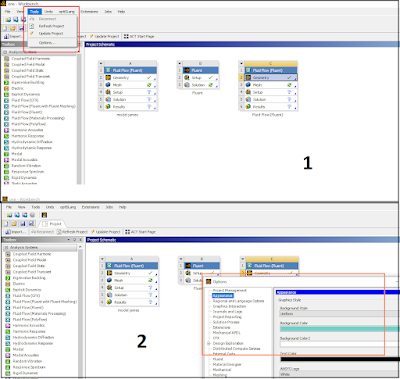OptiSLang is a software for process integration and design optimization, which enables the automation and streamlining of CAE-based simulations. OptiSLang connects with various Ansys tools for simulating different physics domains, such as fluid mechanics, structural mechanics, and optics. OptiSLang uses advanced artificial intelligence and machine learning algorithms to build optimal predictive models, which efficiently explore the design space and identify the best design configurations. OptiSLang allows engineers to make better decisions faster, leading to more innovative designs and shorter time to market .
What are the benefits of using OptiSLang?
Some of the benefits of using OptiSLang are:
- It can automate and streamline the simulation process by integrating multiple CAx tools and different physics domains into a holistic, multi-disciplinary approach to optimization¹.
- It can accelerate the search for the best and most robust design configuration by using state-of-the-art algorithms for design exploration, optimization, robustness and reliability analysis¹.
- It can leverage the latest artificial intelligence and machine learning technologies to build optimal predictive models, which efficiently explore the design space and identify the best design configurations¹².
- It can enable experts to easily create web applications that can be deployed to Ansys Minerva, allowing non-experts to run the application and carry out design studies as needed².
- It can reduce the time and cost of running thousands of designs by using neural networks and smart layout to automatically find the best configuration².
- It can extract the relation from design variables to results as behavior models, which can be implemented in system simulation as table or C-code³.
Source:
(1) Ansys optiSLang | Process Integration & Design Optimization Software. https://www.ansys.com/products/connect/ansys-optislang.
(2) Top 3 New Features in Ansys optiSLang. https://www.ansys.com/en-gb/blog/top-3-new-features-in-ansys-optislang.
(3) Understand your Design - PRACE. https://materials.prace-ri.eu/340/1/robustDesignOptimization.pdf.
What are some use cases of OptiSLang?
Some use cases of OptiSLang are:
- Process integration and design optimization: OptiSLang can automate and streamline the simulation process by integrating multiple CAx tools and different physics into a holistic, multi-disciplinary approach to optimization. OptiSLang can accelerate the search for the best and most robust design configuration by using state-of-the-art algorithms for design exploration, optimization, robustness and reliability analysis¹.
- Reduced-order modeling: OptiSLang can leverage the latest artificial intelligence and machine learning technologies to build optimal predictive models, which efficiently explore the design space and identify the best design configurations. OptiSLang can reduce the time and cost of running thousands of designs by using neural networks and smart layout to automatically find the best configuration¹².
- Model calibration: OptiSLang can extract the relation from design variables to results as behavior models, which can be implemented in system simulation as table or C-code³. OptiSLang can also calibrate these models by comparing them with experimental data and adjusting the parameters accordingly².
- Ansys Minerva integration: OptiSLang can enable experts to easily create web applications that can be deployed to Ansys Minerva, allowing non-experts to run the application and carry out design studies as needed. Ansys Minerva is a platform that enables collaboration, data management, and process automation across the entire product lifecycle².
- Advanced reliability methods: OptiSLang can help engineers make a safety statement for complex systems such as Level 3 autonomous driving assistance systems (ADAS) using scenario-based simulation. OptiSLang can perform uncertainty quantification and reliability analysis based on advanced methods such as Subset Simulation, Importance Sampling, or Line Sampling, which are more efficient and robust than Monte Carlo Sampling.
Source:
(1) Ansys optiSLang | Process Integration & Design Optimization Software. https://www.ansys.com/products/connect/ansys-optislang.
(2) Mastering Ansys optiSLang: 5 Useful Methods for Reusing Existing ... - PADT. https://www.padtinc.com/2022/09/27/ansys-optislang-reusing-results/.
(3) Ansys + Daimler. https://www.ansys.com/content/dam/amp/2021/december/quick-request/optislang-case-study/Ansys-Daimler-Case-Study.pdf.
How can I get a license for OptiSLang?
To get a license for OptiSLang, you need to contact Ansys or one of its authorized partners and request a trial or purchase a subscription. You can find more information about the pricing and packaging of OptiSLang on the Ansys website¹. According to the website, there are two license options for OptiSLang: premium and enterprise. The premium license option allows you to run up to four design point variations concurrently, while the enterprise license option allows you to run up to eight design point variations for a design of experiments (DoE) study³. You also need to have a compatible Ansys product license, such as Ansys Fluent, Ansys Mechanical, or Ansys SPEOS, to use OptiSLang with those tools³.
Source:
(1) Ansys optiSLang | Process Integration & Design Optimization Software. https://www.ansys.com/products/connect/ansys-optislang.
(2) Top 3 New Features in Ansys optiSLang. https://www.ansys.com/blog/top-3-new-features-in-ansys-optislang.
(3) optislang licensing - Ansys Learning Forum. https://forum.ansys.com/forums/topic/optislang-licensing-2/.
(4) Optislang Licensing - Ansys Learning Forum. https://forum.ansys.com/forums/topic/optislang-licensing/.
(5) Download NSYS optiSLang 2022 R1 Win64 full license forever. http://clickdown.org/download-nsys-optislang-2022-r1-win64-full-license-forever/.











